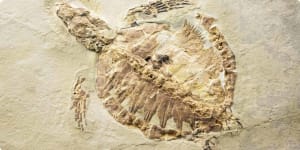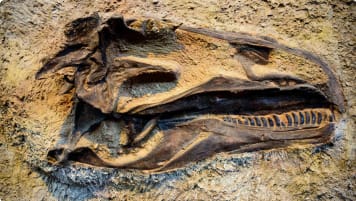Mongolia Dinosaur Dig Tour | Small group tour in the Gobi Desert
The first dinosaur nest of eggs was discovered in Mongolia during 1928.Following an introduction to Mongolian history, culture and desert landscapes, participants will Experience eight days on a paleontological dig. Small group tour for couples and solo mature travellers interested in Mongolia and Dinosaurs.
From A$15,675AUD

Highlights
- 1. Visit the Gandan Monastery and several museums in Ulaanbaatar
- 2. Experience eight days on a paleontological dig
- 3. Learn about the range of fossil vertebrate species recovered in Mongolia
- 4. Explore several significant fossil sites used by the American Museum of Natural History and local paleontologists

Departure Dates
| Departure Date | Price |
|---|---|
| 02 May 2025 Ends 17 May 2025 • 16 days A$16,450 Twin A$19,875 Single Available | Selected |
| 05 September 2025 Ends 20 September 2025 • 16 days A$16,450 Twin A$19,875 Single Available |
Mongolia Dinosaur Dig Tour
This small group educational tour, the Mongolia Dinosaur dig in the Gobi Desert, is arranged under the auspices of the Institute of Palaeontology and Geology, Mongolian Academy of Sciences. The goal of the dinosaur dig in the Gobi Desert is to assist in scientific research and field study projects through sustainable tourism. This is a unique experience to contribute to the world's understanding of Mongolian dinosaurs through palaeontology.
The tour is typically led by one of Mongolia's leading palaeontologists, Dr Tsogtbaatar Khishigjav, along with young Mongolian scientists and the field staff. Dr Tsogtbaatar began his field research and excavation career in the early 1980s. Today, Dr Tsogtbaatar is the director of the Institute of Palaeontology and Geology.
The first nest of dinosaur eggs was discovered in Mongolia in 1928. These local geological beds are especially relevant as they yield not only the dinosaurs remains but also the fossils of mammals and other animal species as well as baby dinosaurs.
Itinerary & highlights for the Dinosaur dig tour
Our small groups palaeontological tour begins in Ulaanbaatar. This city offers an intriguing contrast between ancient traditions and the dawning of a 21st century. Consequently this contrast is seen in the traditional gers and Buddhist monasteries coexisting with modern high-rises. In Ulaanbaatar, you visit Gandan Monastery, the seat of Buddhism in Mongolia. In the monastery grounds, you hear the low tones of the horns used to call the lamas to the temple. While here you can observe their daily rituals, including the reading of the sutras. You also visit the National History Museum for an overview of Mongolia’s history and culture. Finally, you will also have the opportunity to tour the Mongolian Paleontological Laboratory.
After our time in Ulaanbaatar, you travel through the Gobi, Mongolia’s southernmost province of semi-arid desert. Of all the world’s arid lands, the Gobi (which means simply “desert”) has about it the greatest air of mystery. Probably because it lies at the heart of Asia’s remotest hinterland between the Siberian wilderness to the north and the Tibetan Plateau to the south. Contrary to the sterile sameness that the word “desert” suggests, the Gobi holds many fascinations. Especially relevant to this tour are the sites of some of the most important palaeontological discoveries of this century.
The Dinosaurs of the Gobi small group tour includes ten days on a palaeontological dig. You have the opportunity to recover specimens of various dinosaur and mammal species in the fossil rich Tugrigiin Shiree. This geological formation was discovered by Mongolian scientists in the late 1950's. Since its discovery it was then co-explored by Polish expeditions in the late 1960s and early 1970s. As a result of this work the Tugrigiin Shiree is perhaps most known for its famous "Fighting Dinosaurs” (a fossil of a Protoceratops and a Velociraptor locked in combat). For this part of the trip, you will almost be living as palaeontologists, joining and following the research team in their daily work. As a result you have the opportunity to participate in actual excavations and make new discoveries. Following each day's adventurous prospecting, the group expert field-chef will serve a hearty meal. View an article of the tour from Oct 2016.
This Dinosaur dig is one of a series of archaeology tours that Odyssey offers around the world each year.
If you would like to learn more about Mongolia, explore Odyssey's country profile. For more details, click the ‘Top 5’ or ‘Itinerary’ buttons above! If you’re keen to experience this tour, please call or send an email. Or, to book, simply fill in the form on the right hand side of this page.
Gallery
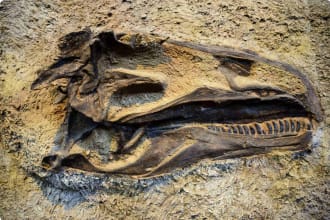
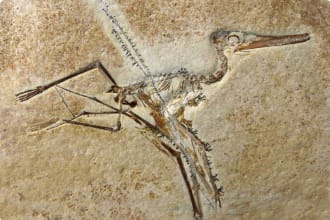
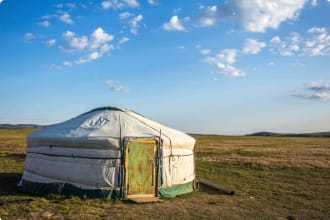

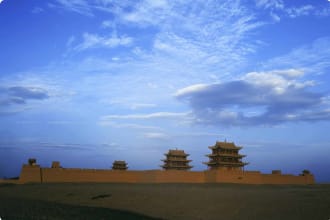
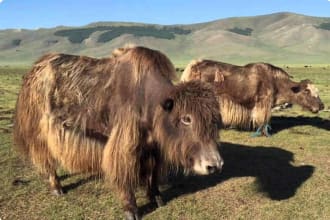
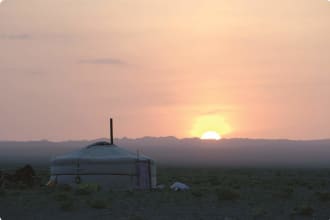
Itinerary
15 days
Day 1: Ulaanbaatar
Accommodation: Ulaanbaatar Hotel; D
The contrast between ancient traditions and the dawning of a 21st century democracy is most visible in Ulaanbaatar where traditional gers and Buddhist monasteries coexist with modern high-rises.
Upon arrival at the hotel located near downtown Ulaanbaatar the group meets in the afternoon. Enjoy a welcome dinner at a fine local restaurant.
Day 2: Ulaanbaatar
Accommodation: Overnight at the hotel. (Ulaanbaatar Hotel; B, L, D)
Begin the day with a visit to Gandan Monastery, the seat of Buddhism in Mongolia. Strolling through the monastery grounds, you will hear the low tones of the horns used to call the lamas to the temple and can observe their daily rituals, including the reading of sutras (teachings of the Buddha). Also visit the recently reconstructed Chenrezi and Kalachakra Temples, as well as the magnificent statue of Migjid Janraisig (“the lord who looks in every direction”). This 82-foot high statue, gilded in pure gold and clothed with silk and precious stones, completely fills one of Gandan’s temples.
After lunch, drive through downtown Ulaanbaatar to the National History Museum for an excellent overview of Mongolia’s history and culture. The newly remodeled museum displays traditional implements of daily nomadic life including Stone and Bronze Age artifacts, historical costumes of Mongolia’s minority tribes, sacred religious relics, and agricultural, fishing and hunting equipment.
Next, travel back in time with a visit to the dinosaur halls of the Natural History Museum, showcasing the spectacular fossils found in the Gobi desert. On display are fierce Tarbosaurous fossils (closely related to Tyrannosaurus rex), dinosaur eggs, large Hadrosaur fossils (duck-billed dinosaurs), and many others, all of which illustrate the richness and importance of the paleontological sites in the Gobi desert. Also visit the paleontological laboratory of the Academy of Sciences and enjoy a private behind-the-scenes look at fossils that are being prepared for exhibition. In the evening, enjoy dinner at a fine local restaurant.
Day 3: Gobi/ Flaming Cliffs
Accommodation: Three Camel Lodge: B, L, D
In the morning, fly over vast steppe to the Gobi (1.5 hours), Mongolia’s southernmost province of semi-arid desert. Of all the world’s arid lands, the Gobi (which means simply “desert”) has about it the greatest air of mystery, perhaps because it lies at the heart of Asia’s remotest hinterland between the Siberian wilderness to the north and the Tibetan Plateau to the south. Contrary to the sterile sameness that the word “desert” suggests, the Gobi holds many fascinations including sites of some of the most important paleontological discoveries of this century.
Upon arrival, transfer to the Three Camel Lodge. In the afternoon, drive to the legendary “Flaming Cliffs,” named for the red-sandstone that glows a brilliant reddish-orange at sunset. It was here, in 1922, that Dr. Roy Chapman Andrews and his exploration team from the American Museum of Natural History found the first nest of dinosaur eggs the world had ever seen. Explore the cliffs, which abound with numerous scattered fossil remains. In the evening return to the lodge and overnight.
Day 4: Hongoryn Els Sand Dunes
Accommodation: Ger Camp; B, L, D
After breakfast, drive to Hongoryn Els (5 hour drive), which means “Singing Sands” in Mongolian. Picnic lunch on the way. Though the Gobi is primarily a stony desert covered with a sparse layer of scrub vegetation, there are a few areas where you can find the traditional desert landscape of seemingly endless sand dunes. Hongoryn Els is the largest of these areas, with dunes reaching upwards of 800m and extending parallel to the Gobi Altai Mountains for approximately 100 km. Dinner and overnight at the ger camp.
Day 5: Hongoryn Els / Nemegt basin
Accommodation: Tent Camp; B, L, D
After early breakfast, drive from Hongoryn Els through the austere and beautiful Gobi landscape to Nemegt basin (7 hour drive). Spend the next eight days prospecting for and excavating fossils. Discovered by a joint Soviet/Mongolian expedition in 1946, the labyrinth of gorges which comprise the Nemegt basin has yielded specimens of various dinosaurs, early mammals and other organisms, including the forbidding Tarborsaurus baatar (a relative of Tyrannosaurus rex), Saurolophus angustirostris, and Therizinosaurus cheloniformis.
During the expedition, our guides will set up camp with tents for every two people, outfitted with sleeping bags and mats.
Day 6-7-8-9-10-11-12: Nemegt Basin
Accommodation: Tent Camp; B, L, D
Days in the field typically begin at 7:00 am with a hearty breakfast at 8:00 am. You will then prospect for the rest of the day under the supervision of Dr. Badamgarav, with a break for lunch. After dinner, Dr. Badamgarav will review the day’s work and discuss the significance of any discoveries.
Day 13: Ukhaa Tolgod
Accommodation: Tent or Ger Camp; B, L, D
After breakfast, drive to the now legendary Ukhaa Tolgod, the newest site which the American Museum of Natural History discovered in the mid-1990s. Ukhaa Tolgod is known for the fossilized egg embryo, which was found here almost complete. Continue driving to Hongoryn Els in time for dinner and overnight. (Approximately 7 hours driving.
Day 14: Three Camel Lodge
Accommodation: Three Camel Lodge; B, L, D
After an early breakfast, drive to Tugrigiin Shiree, first discovered and explored by Polish expeditions in the late 60s and early 70s. Tugrigiin Shiree is perhaps most known for its famous “Fighting Dinosaurs” (a fossil of a Protoceratops and a Velociraptor locked in combat), which were discovered in the 1970s. Explore this white-sandstone escarpment and nearby sand dune. In the late afternoon, continue your journey in the South Gobi until you reach Nomadic Expeditions’ Three Camel lodge ger camp.
Day 15: Ulaanbaatar
Accommodation: Ulaanbaatar Hotel; B, L, D
After breakfast, drive to Dalanzadagad for your return flight to Ulaanbaatar. Upon arrival, transfer to your hotel.
Following lunch, drive to the Zanabazar Fine Arts Museum, named in honor of the renowned 17th century artist and politician, who was also the first Buddhist leader of Mongolia. The museum contains one of the best collections of Buddhist art and artifacts in the world, including many of Zanabazar’s original works.
In the evening, we’ll attend a performance featuring traditional Mongolian dancers and hoomi (throat) singers. Overnight at hotel.
Day 16: Departure
Tour concludes after breakfast. (B)
Tour Notes
- Group size is limited to 12 participants.
Includes / Excludes
What’s included in our Tour
- 15 nights accommodation in lodges, gers and tented camps.
- 15 breakfasts, 15 lunches and 15 dinners.
- 2 internal flights and taxes (economy class, baggage limit may apply).
- All sightseeing including entrance fees.
- Services of an English speaking guide.
- Odyssey Tour Leader for the duration of the tour.
- Detailed tour information booklet.
What’s not included in our Tour
- Return international airfare and departure taxes.
- Comprehensive international travel insurance.
- Mongolia Visa fees (where applicable).
- Items of a personal nature such as telephone calls and laundry.
Participants must be able to carry their own luggage, climb and descend stairs, be in good health, mobile and able to participate in 3-5 hours of physical activity per day, the equivalent of walking / hiking up to 8 kilometers per day on uneven ground.
Book now
Make it a private tour
Easing your journey
Crossing international borders with restrictions
The list of requirements to travel internationally has changed and will continue to change for several years. Odyssey is here to assist you in managing your way through these requirements:
For more information see our Crossing international borders with restrictions page.
Book With Confidence
If less than 30 days before your tour starts you are unable to travel as a result of Government travel restrictions, Odyssey Traveller will assist you with a date change, provide you with a credit or process a refund for your booking less any non-recoverable costs.
See Terms and conditions for details.
Peace of Mind Travel
The safety of our travellers, tour leader, local guide and support staff has always been our top priority and with the new guidelines for public health and safety for keeping safe for destinations around the world, we’ve developed our plan to give you peace of mind when travelling with us.
See Peace of Mind Travel for details.
Reading List Download PDF
The Rise and Fall of the Dinosaurs: The Untold Story of a Lost World
Steve Brusatte
66 million years ago the dinosaurs were wiped from the face of the earth. Today, Dr. Steve Brusatte, one of the leading scientists of a new generation of dinosaur hunters, armed with cutting edge technology, is piecing together the complete story of how the dinosaurs ruled the earth for 150 million years.
The world of the dinosaurs has fascinated on book and screen for decades – from early science fiction classics like The Lost World, to Godzilla terrorizing the streets of Tokyo, and the monsters of Jurassic Park. But what if we got it wrong? In The Rise and Fall of the Dinosaurs, top dinosaur expert Brusatte, tells the real story of how dinosaurs rose to dominate the planet. Using the fossil clues that have been gathered using state of the art technology, Brusatte follows these magnificent creatures from their beginnings in the Early Triassic period, through the Jurassic period to their final days in the Cretaceous and the legacy that they left behind.
Along the way, Brusatte introduces us to modern day dinosaur hunters and gives an insight into what it’s like to be a paleontologist. The Rise and Fall of the Dinosaurs is full of thrilling accounts of some of his personal discoveries, including primitive human-sized tyrannosaurs, monstrous carnivores even larger than T. rex, and feathered raptor dinosaurs preserved in lava from China.
At a time when Homo sapiens has existed for less than 200,000 years and we are already talking about planetary extinction, The Rise and Fall of the Dinosaurs is a timely reminder of what humans can learn from the magnificent creatures who ruled the earth before us.
Weird Dinosaurs: The Strange New Fossils Challenging Everything We Thought We Knew
John Pickrell
From the outback of Australia to the Gobi Desert of Mongolia and the savanna of Madagascar, award-winning science writer and dinosaur enthusiast John Pickrell embarks on a world tour of new finds, meeting the fossil hunters working at the frontier of discovery. He reveals the dwarf dinosaurs unearthed by an eccentric Transylvanian baron; an aquatic, crocodile-snouted carnivore bigger than T. Rex, which once lurked in North African waterways; a Chinese dinosaur with wings like a bat; and a Patagonian sauropod so enormous it weighed more than two commercial jet airliners.
Other surprising discoveries hail from Alaska, Siberia, Canada, Burma, and South Africa. Why did dinosaurs grow so huge? How did they spread across the world? Did they all have feathers? What do sauropods have in common with 1950s vacuum cleaners? The stuff of adventure movies and scientific revolutions, Weird Dinosaurs examines the latest breakthroughs and new technologies radically transforming our understanding of the distant past. Pickrell opens a vivid portal to a brand new age of fossil discovery, in which fossil hunters are routinely redefining what we know and how we think about prehistory’s most iconic and fascinating creatures.
Dinosaurs of the Flaming Cliffs: The Thrilling Account of One of the Largest Dinosaur Expeditions of the 20th Century by the Expedition Leader
Michael Novacek
In 1993, an international team of paleontologists from the American Museum of Natural History and the Mongolian Academy of Sciences, in the fourth year of a multiyear expedition, made one of the most miraculous fossil discoveries in history. They unearthed a treasure trove of Cretaceous dinosaurs and mammals, including several new species, that has already helped to reshape our understanding of the dinosaur age. In Dinosaurs of the Flaming Cliffs, team leader Michael Novacek, Provost of Science of the American Museum of Natural History and Curator of Vertebrate Paleontology, re-creates the day-to-day drama of field exploration over the past six years in the Gobi and recounts his and his colleagues' historic discoveries, reported in front-page headlines across the world. In a remarkable narrative that interweaves expedition chapters with in-depth scientific discussions on the nature and importance of the fossil record, Novacek takes us on a journey that explores the very nature of scientific inquiry and dinosaur research.
Age of Dinosaurs Russia & Mongolia
Michael J Benton
The former Soviet Union covers a vast area of land, and over the last 200 years, many dozens of extraordinary dinosaurs and other fossil amphibians, reptiles, birds and mammals have been found in Mesozoic rocks in its territories. The Permo-Triassic of the Ural Mountains of Russia have produced hundreds of superb specimens, and many of the dinosaurs from Mongolia are unique. This is the first compilation in any Western language of this large body of Russian research and the first time so much of this research, previously unexplored by the West, has been introduced in English. The Age of Dinosaurs in Russia and Mongolia is written by a unique mix of Russian and Western palaeontologists, and provides an entrée to a range of fossil faunas, in particular reptiles, that have been little known outside Russia. It will undoubtedly become a major reference work for all vertebrate palaeontologists.
Pterosaurs: Natural History, Evolution, Anatomy
Mark Whitton
For 150 million years, the skies didn't belong to birds--they belonged to the pterosaurs. These flying reptiles, which include the pterodactyls, shared the world with the nonavian dinosaurs until their extinction 65 million years ago. Some pterosaurs, such as the giant azhdarchids, were the largest flying animals of all time, with wingspans exceeding thirty feet and standing heights comparable to modern giraffes. This richly illustrated book takes an unprecedented look at these astonishing creatures, presenting the latest findings on their anatomy, ecology, and extinction. Pterosaurs features some 200 stunning illustrations, including original paintings by Mark Witton and photos of rarely seen fossils. After decades of mystery, paleontologists have finally begun to understand how pterosaurs are related to other reptiles, how they functioned as living animals, and, despite dwarfing all other flying animals, how they managed to become airborne. Here you can explore the fossil evidence of pterosaur behavior and ecology, learn about the skeletal and soft-tissue anatomy of pterosaurs, and consider the newest theories about their cryptic origins. This one-of-a-kind book covers the discovery history, paleobiogeography, anatomy, and behaviors of more than 130 species of pterosaur, and also discusses their demise at the end of the Mesozoic. * The most comprehensive book on pterosaurs ever published * Features some 200 illustrations, including original paintings by the author * Covers every known species and major group of pterosaurs * Describes pterosaur anatomy, ecology, behaviors, diversity, and more * Encourages further study with 500 references to primary pterosaur literature
Dinosaurs: How They Lived and Evolved
Darren Naish
From the Victorian golden age of dinosaur discovery to the cutting edge of twenty-first century fossil forensics 'Dinosaurs' unravels the mysteries of the most spectacular group of animals our planet has ever seen. Despite facing drastic climatic conditions including violent volcanic activity, searing temperatures and rising and plunging sea levels, the dinosaurs formed an evolutionary dynasty that ruled the Earth for more than 150 million years. Darren Naish and Paul Barrett reveal the latest scientific findings about dinosaur anatomy, behaviour, and evolution. They also demonstrate how dinosaurs survived the great extinction at the end of the Cretaceous Period and continued to evolve and thrive alongside us, existing today as an incredibly diverse array of birds that are the direct descendants of theropods. 'Dinosaurs' is lavishly illustrated with specimens from the Natural History Museum's own collections, along with explanatory diagrams and charts and full-colour artistic reconstructions of dinosaur behaviour.
